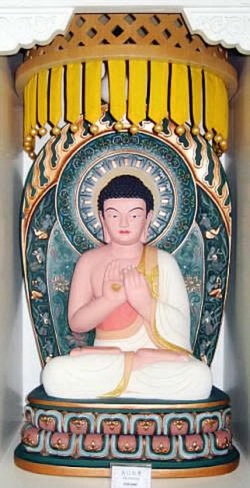Difference between revisions of "Chin-kang-chih"
| Line 3: | Line 3: | ||
[[Chin-kang-chih]] | [[Chin-kang-chih]] | ||
| − | [[金剛智]] (671–741) (PY | + | [[金剛智]] (671–741) (PY [[Jingangzhi]]; Skt [[Vajrabodhi]]; Jpn [[Kongochi]]) |
An [[Indian]] [[monk]] who went to [[China]] to disseminate [[Esoteric Buddhism]]. [[Chin-kang-chih]] is his {{Wiki|Chinese}} [[name]]. Born in southern [[India]] (or {{Wiki|central}} [[India]] according to some sources), he entered [[Nalanda Monastery]] at age ten and formally received the [[precepts]] at twenty. He studied the [[monastic]] [[disciplines]] of [[Hinayana]] and [[Mahayana]], as well as The Treatise on the [[Lamp]] of [[Wisdom]], The [[One-Hundred-Verse Treatise]], The [[Treatise on the Twelve Gates]], and other treatises. At thirty-one, he became a [[disciple]] of [[Nagabodhi]], who initiated him into the study of the [[esoteric]] [[scriptures]]. In 720 [[Chin-kang-chih]] went to {{Wiki|Lo-yang}} in [[China]], where he won the {{Wiki|patronage}} of [[Emperor]] {{Wiki|Hsüan-tsung}} and translated into {{Wiki|Chinese}} several [[esoteric]] scriptures,a four-volume [[sutra]], translated by [[Chin-kang-chih]] ([[Vajrabodhi]]) in the early eighth century; including the [[Diamond Crown Sutra]]. The [[True Word]] ( Jpn [[Shingon]]) school regards him as the [[fifth patriarch]] in the [[lineage]] of [[Esoteric Buddhism]]. His [[disciple]] [[Pu-k'ung]] (Skt [[Amoghavajra]]) succeeded him. | An [[Indian]] [[monk]] who went to [[China]] to disseminate [[Esoteric Buddhism]]. [[Chin-kang-chih]] is his {{Wiki|Chinese}} [[name]]. Born in southern [[India]] (or {{Wiki|central}} [[India]] according to some sources), he entered [[Nalanda Monastery]] at age ten and formally received the [[precepts]] at twenty. He studied the [[monastic]] [[disciplines]] of [[Hinayana]] and [[Mahayana]], as well as The Treatise on the [[Lamp]] of [[Wisdom]], The [[One-Hundred-Verse Treatise]], The [[Treatise on the Twelve Gates]], and other treatises. At thirty-one, he became a [[disciple]] of [[Nagabodhi]], who initiated him into the study of the [[esoteric]] [[scriptures]]. In 720 [[Chin-kang-chih]] went to {{Wiki|Lo-yang}} in [[China]], where he won the {{Wiki|patronage}} of [[Emperor]] {{Wiki|Hsüan-tsung}} and translated into {{Wiki|Chinese}} several [[esoteric]] scriptures,a four-volume [[sutra]], translated by [[Chin-kang-chih]] ([[Vajrabodhi]]) in the early eighth century; including the [[Diamond Crown Sutra]]. The [[True Word]] ( Jpn [[Shingon]]) school regards him as the [[fifth patriarch]] in the [[lineage]] of [[Esoteric Buddhism]]. His [[disciple]] [[Pu-k'ung]] (Skt [[Amoghavajra]]) succeeded him. | ||
Latest revision as of 02:55, 9 November 2013
Chin-kang-chih
金剛智 (671–741) (PY Jingangzhi; Skt Vajrabodhi; Jpn Kongochi)
An Indian monk who went to China to disseminate Esoteric Buddhism. Chin-kang-chih is his Chinese name. Born in southern India (or central India according to some sources), he entered Nalanda Monastery at age ten and formally received the precepts at twenty. He studied the monastic disciplines of Hinayana and Mahayana, as well as The Treatise on the Lamp of Wisdom, The One-Hundred-Verse Treatise, The Treatise on the Twelve Gates, and other treatises. At thirty-one, he became a disciple of Nagabodhi, who initiated him into the study of the esoteric scriptures. In 720 Chin-kang-chih went to Lo-yang in China, where he won the patronage of Emperor Hsüan-tsung and translated into Chinese several esoteric scriptures,a four-volume sutra, translated by Chin-kang-chih (Vajrabodhi) in the early eighth century; including the Diamond Crown Sutra. The True Word ( Jpn Shingon) school regards him as the fifth patriarch in the lineage of Esoteric Buddhism. His disciple Pu-k'ung (Skt Amoghavajra) succeeded him.
